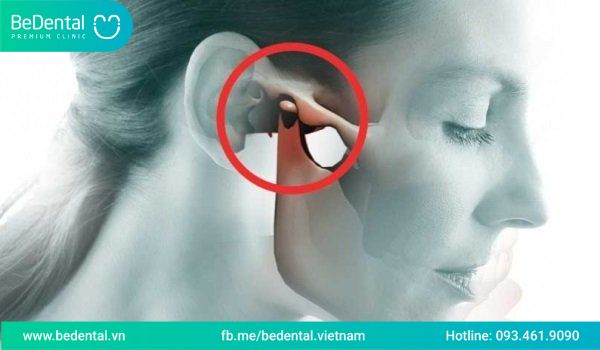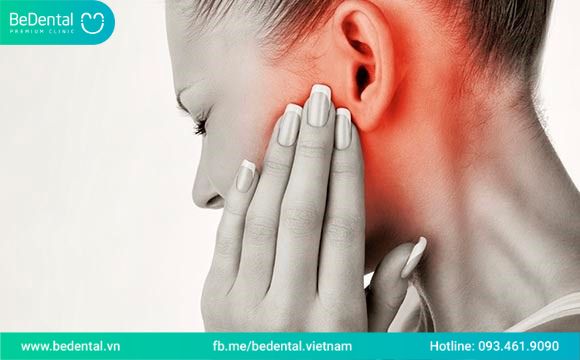TEMPOROMATIC DISEASE: MOUTH OPEN WITH SOUNDS. In everyday life, we often open our mouths to eat or drink or yawn. However, if you detect joint sounds when opening your mouth, it may be a sign of temporomatic disease. This can affect our health and daily life. In addition, there is also temporary joint adhesion when opening the mouth, causing difficulty in moving the jaw smoothly, especially when sleeping or waking up in the morning. Therefore, a clear understanding of this phenomenon and appropriate treatment is extremely necessary.
So what is the cause of temporomatic disease? How to cure the sound of mouth opening? In this article, we will learn about the temporomatic disease that makes noise when opening the mouth and the phenomenon of temporary joint adhesion when opening the mouth to be able to solve this problem effectively. Let Bedental answer these questions for you through the article below!
What is temporomatic disease?
Temporomandibular arthritis , also known as temporomatic joint disorder, is a joint disorder that affects the temporomandibular joint, which includes the facet of the mandible and temporal bone.

This disease includes problems such as painful periods, muscle spasms, and imbalances in the joints between the jaw and skull. The temporomandibular joint, which plays an important role in activities such as eating, speaking, drinking, and swallowing, can lose function due to the impact of this disease, significantly affecting daily activities.
What is the cause of temporomatic disease?
What is the cause of temporomatic disease? First of all, we need to observe the normal anatomy of the Temporomandibular joint.
The blue part is the articular disc that is always located on top of the condyle. When you open your mouth, the condyle goes forward and the articular disc also follows. When you close your mouth, the condyle recedes and the articular disc also recedes, maintaining its original shape. Such a relationship between the ball and the joint disc is called healthy.
However, recurrent articular disc slippage is an abnormal relationship. Before biting the jaw, the articular disc has slipped out and the condyle can recapture this articular disc to achieve the normal relationship described in the biological structure. If the upper part is healthy, it is called regenerative (i.e. can return to normal) because of the ability to recapture the articular disc.

Through the image, you can see that the articular disc initially dislocates first, pushing the ball back. When the patient opens his mouth, the ball catches the articular disc. The moment the disc is caught is when you hear the sound of the head popping. fairy. When he closed his mouth, the disc dislodged again and a second sound appeared.
So, you can partly imagine why there is a noise, where it comes from, in fact it is just the sound of the articular disc colliding when catching and leaving the ball of the disc in disc dislocation.
See more: How long does dental filling last? Important considerations after dental filling
How to cure mouth opening with sounds?
How to cure mouth opening noise? In fact, joint noise is not a treatment target for maxillofacial surgery, nor is it associated with symptoms of pain or jaw dysfunction.
Many studies have shown that joint sounds often come and go on their own. The treatment of opening the mouth with noise is if the cry appears along with pain, causing dysfunction.
Even if a temporomandibular joint is noisy, it can still be considered stable if the body has adapted. It is only considered unstable when occasionally experiencing symptoms of jaw lock or pain or movement disorders.
However, if the joint noise makes the patient uncomfortable, can it be completely cured? The answer is that it is still possible to cure, but it is difficult to predict, so doctors always prioritize conservative treatment instead of surgery.
See more: 5 causes of porcelain tooth sensitivity?
Common ways to treat mouth opening with sounds
Behavioral therapy
Patients with temporomatic diseases will be instructed by the doctor about the disease they have and understand the progression and harmful effects of the disease. When patients understand their disease and how to treat it, they will worry less. They will also proactively seek information and solutions to support the treatment process.
In Vietnam, many doctors think that patients lack medical knowledge, so they only explain superficially, but that is not entirely accurate. Currently, patients can easily access medical information thanks to the development of the internet. Therefore, letting patients know clearly about the disease can help them feel at ease and coordinate treatment better.
Behavioral therapy also emphasizes controlling emotions, using healthy foods, and sleeping. For example, do not smoke, use alcohol, do not drink coffee before bed, etc.
In addition, behavioral therapy also helps patients better control their emotions and get rid of negative emotions and thoughts. If those negative emotions are not eliminated soon, they will keep the patient in a vicious cycle, feeling miserable and can distort one’s perception of reality.
Use physical therapy
The most famous way to treat temporomandibular disease is Isokinetic exercises. In 1993, authors Klineberg and Au used the exercise on 22 patients complaining of joint sounds.
Perform the exercise by opening and closing the jaw about 15mm, moving the jaw left and right 5mm. When the jaw moves, use your hand to gently force it. After about 6 months of practice and monitoring, 82% of patients no longer had joint sounds.
According to research by Yoda’s group in 2003, 61.9% of patients had a clear reduction in joint sounds after three months of practicing the exercise of moving the jaw forward and moving the jaw back. Exercise diagram of the Yoda author group. Functional muscle training methods can completely eliminate joint noise without being expensive and without harming the body.

See more: Best Dental Clinics Near Me in Hanoi
Use a chewing trough
In 2011, author Huang treated 59 patients with painless joint sounds with a stabilization splint. 6 months later, he found that the joint sounds had disappeared in 71.2% of patients. Conti in 2006 studied 57 patients complaining of joint noise and pain. Patients were divided into 3 groups based on treatment:
- The group wore braces to balance the bite on both sides.
- The manger group has canine guides.
- The group wore prosthetic mouthpieces without the plastic part covering the bite.
Statistical results show that patients wearing chewing gums have a higher rate of pain improvement as well as the disappearance of mouth-opening sounds compared to the group using a fake mouthpiece, which proves the effectiveness of chewing mouthpieces compared to the placebo effect. .
Hyaluronic acid injection method into joints (HA)
Whether the synovial fluid in the TMJ joint affects the appearance or recovery of joint sounds or not, there is still no clear evidence, but Hyaluronic acid is still used to treat problems related to the TMJ. intra-articular.
In 2009, Bastezi and his colleagues treated 20 patients with recurrent slipped discs and 2-stroke joint sounds by injecting Hyaluronic acid directly into the joint for 3 weeks at a certain dose.
After about a year of follow-up, they found a significant reduction in symptoms of joint noise and joint pain. However, this study did not have a scientific research design, so more clear research is needed to consider widespread application in treatment.

In addition to the above methods, which are all non-invasive treatments, there are also surgical methods. However, surgical treatment faces many different risks and complications may occur.
Therefore, only when the mouth gaping noise causes discomfort, pain or affects the function of the mouth should treatment measures be considered. As for surgery to treat mouth opening noise, it should not be performed because of the risks it brings, not to mention surgery has been proven to not be an effective way to treat the disease.

Therefore, we at BeDental always prioritize the application of non-invasive measures to treat mouth opening noise to bring optimal treatment results without causing danger to customers, if you are having problems with your mouth. If you hear a cry when you open your mouth, quickly contact us immediately for advice, examination and a suitable treatment plan.
BeDental has many years of experience and a team of highly skilled doctors in the fields of maxillofacial dentistry such as porcelain veneers, porcelain crowns, dental implants… Trusted by many customers and chosen as a place for their dental care. Treat your molar condition. Currently, BeDental is becoming more and more popular with many customers because of its cosmetic dental technology such as braces, porcelain veneers,…
If you are in need of cosmetic dentistry but are concerned about the cost of braces, porcelain crowns, teeth whitening, etc., then don’t worry and contact us for advice. Free savings, BeDental always has beneficial and economical services suitable for each customer’s finances such as installment braces service,…

Above is a detailed article about the causes and treatments of temporomatic disease: when opening the mouth there is a cry. Hopefully the article has brought you useful information about temporomatic disease, if there is any. If you have any questions, please contact BeDental for completely free consultation.
Tư vấn chuyên môn bài viết:
BÁC SĨ DƯƠNG THỊ THÙY NGA
BEDENTAL - TOP STANDARD DENTISTRY SYSTEM
In HANOI
Address 1: 7B Thi Sach St, Ngo Thi Nham, Hai Ba Trung Dist, Ha Noi. - 0934.61.9090
Address 2: No 129 Hoang Ngan, Yen Hoa, Cau Giay Dist, Ha Noi. - 0934.61.9090
In HO CHI MINH
Address 1: 53 -55 -57 Pho Duc Chinh St, Nguyen Thai Binh, Dist. 1, Ho Chi Minh. - 0766.00.8080
Working: 9am - 8pm everyday
Website: https://bedental.vn/en/





